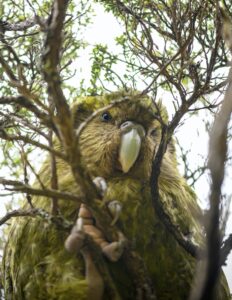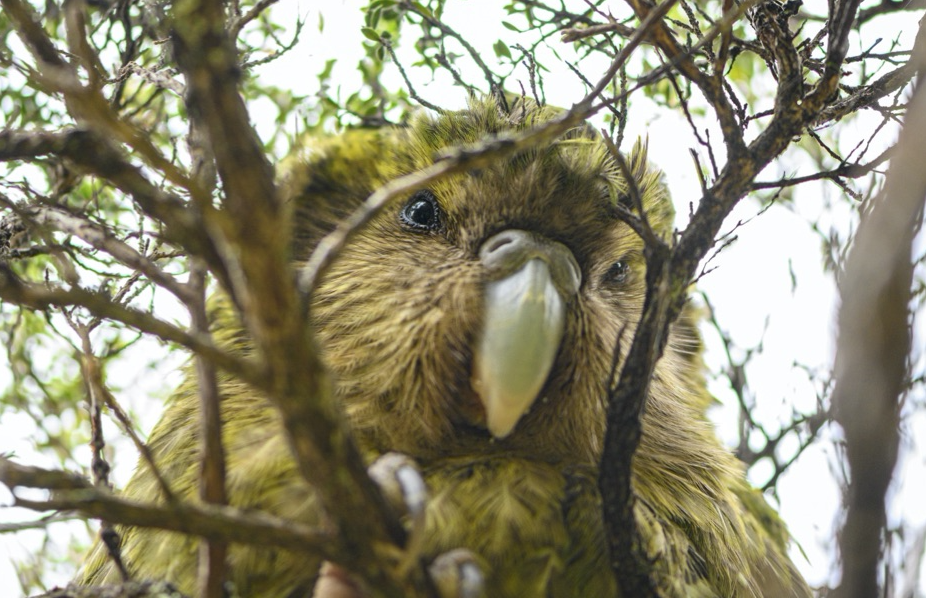Efforts to diversify an inbred population must take into account the genetic backgrounds of the founders.

Photo by Jake Osborne.
The nocturnal flightless parrot known as the kākāpō was once abundant throughout New Zealand. But after the introduction of mammalian predators, the species all but disappeared. Today, every living kākāpō is descended from a tiny handful of island survivors and a single male from the mainland. The entire population of 201 birds is closely watched over by conservationists on a few predator-free island refuges, where they hope the hefty green parrots will continue to breed.
But because their numbers dropped into the double digits, the kākāpō face a genetic bottleneck. Inbreeding can increase rates of genetic disease and contribute to poor health among the population. Geneticists studying the remaining kākāpō have quantified the amount of inbreeding among the birds as one way to understand the health of the species. Their results, reported in a new paper in G3: Genes|Genomes|Genetics, suggest that inbreeding isn’t necessarily hurting chicks’ chances of survival and that introducing additional genetic diversity may not always have the intended effect.
Saved from extinction
“Kākāpō have a really interesting natural history,” says Yasmin Foster, a graduate student at the University of Otago and the study’s lead author. “They were functionally extinct, but then a small population was found on an island in the south of New Zealand.”
“Functionally extinct” in this case meant no more females could be found on the New Zealand mainland; only a few males remained. In 1977, about 50 kākāpō were discovered living on Stewart Island, a large island about 19 miles south of the mainland. Predators such as feral cats roamed Stewart Island, however, so in 1982 conservationists began relocating the birds to several smaller, mammal-free outlying islands.
By then, only one male kākāpō remained on the mainland, and he was taken to a predator-free island refuge along with the Stewart Island population. The Stewart Island kākāpō had diverged from the mainland population around 10,000 years ago, giving the two groups time to develop distinct genetic profiles. Introducing the mainland bird was meant to help boost genetic diversity among a new generation of chicks.
Now, the population has grown to 201 individuals. To help inform conservation strategies, Foster and her colleagues set out to document the amount of inbreeding in the colony. Creating a large, multigenerational pedigree of the wild kākāpō wouldn’t work for a founder population of this type, so the researchers turned to DNA sequence analysis. Thanks to the availability of a high-quality kākāpō reference genome, the team could genotype the birds using genome-wide mapping of single nucleotide polymorphisms (SNPs).
Comparing measures of inbreeding
“We had this unique founding population with 50 Stewart Island birds and one mainland male,” says Foster. “From the inbreeding metrics I looked at, we found that they’re both inbred, but in different ways.” She says the study raises an interesting point about how combining two inbred populations in an attempt to increase genetic diversity can actually introduce more deleterious alleles.
Comparing multiple inbreeding metrics helped Foster get a robust view of the birds’ genome, and also to evaluate the accuracy of each one. “Some people just use one or another, but what I found was that some of them give a different story,” she says.
She started by calculating the coefficient of inbreeding, or FH, which is the probability of an individual inheriting two copies of the same allele from the same ancestor on both sides. She compared this with a newer method of measurement, called “runs of homozygosity” or FROH, which looks for long sections of the genome where both copies are the same.
A third method, using pairwise analysis to construct a genomic-relatedness matrix, turned out to be the weakest of the metrics, Foster says. “Other people have found that when you have a small group of individuals that are a lot different to the larger group, they skew the outcome maybe a bit too much,” she says. “Their genetic information is more rare, and the way the maths compute this inbreeding metric, it gives more power to those rare alleles.”
‘Hybrid vigor’ – or not
In addition, they compared levels of inbreeding with survival in chicks. When the mainland male was added to the Stewart Island population, the expectation was that he would infuse genetic diversity into a new generation of chicks, boosting their health. But that turned out not to be the case: decreased inbreeding did not correspond to improved survival, partly because the less-inbred chicks had unexpectedly high levels of mortality.
“That was probably down to the mainland individuals also being reduced to a small population for a long period of time,” says Foster. The mainland male apparently brought in quite a few detrimental mutations that had been lost from the island population over the years.
The inbreeding study and others like it could help guide conservation strategies moving forward. Kākāpō have a lek mating system, which means that the males all congregate and compete to entice the females. The most popular male will produce the most offspring, and this can tighten the genetic bottleneck even more.
“One male kākāpō had fathered 22 chicks, which is really significant when there’s only 200 left,” says Foster. “Obviously his genetic material spread across the population. He was so successful, we had to translocate him to another island to give some of the other males a chance.”
CITATION
Genomic signatures of inbreeding in a critically endangered parrot, the kākāpō
Yasmin Foster, Ludovic Dutoit, Stefanie Grosser, Nicolas Dussex, Brodie J. Foster, Ken G. Dodds, Rudiger Brauning, Tracey Van Stijn, Fiona Robertson, John C. McEwan, Jeanne M. E. Jacobs, and Bruce C. Robertson
G3 Genes|Genomes|Genetics 2021; jkab307













